

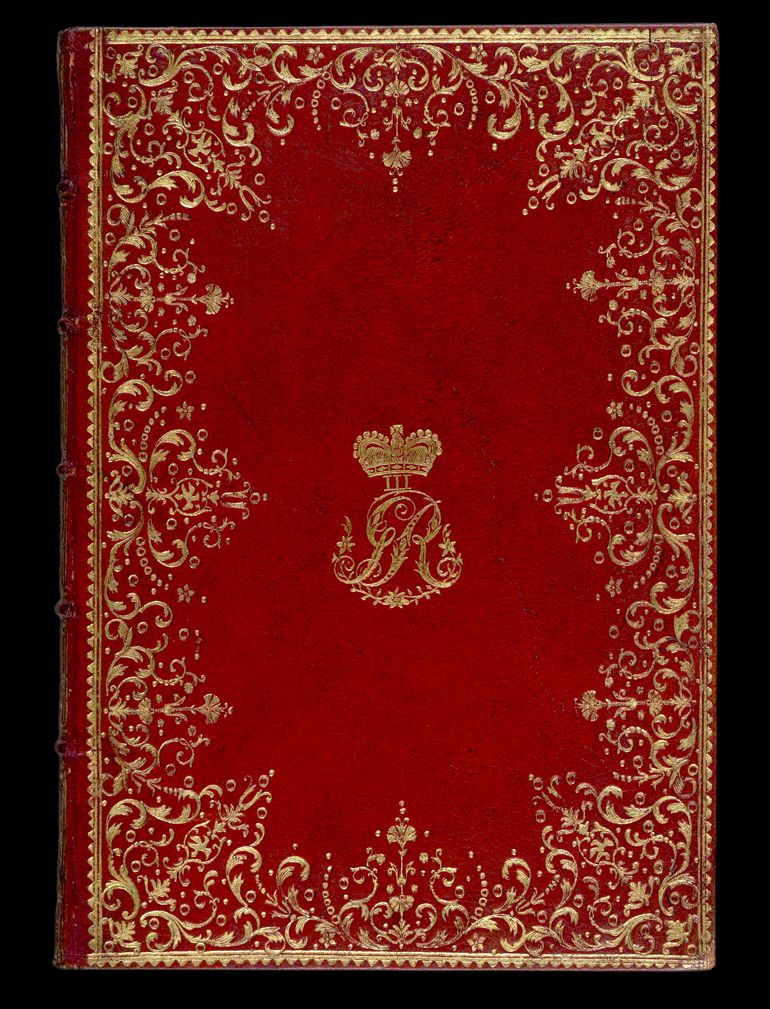
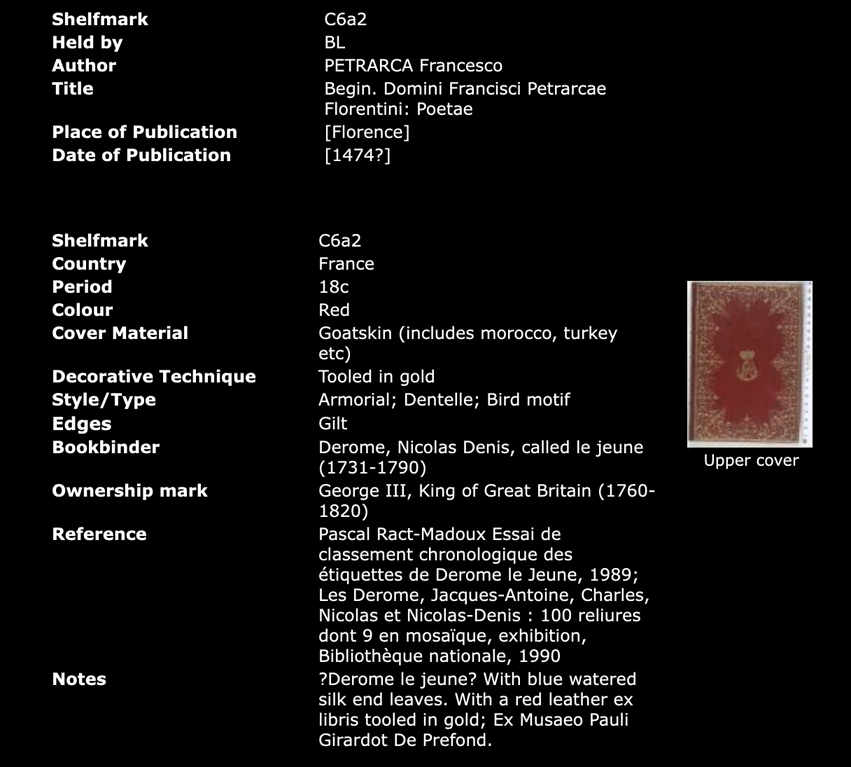
|
While searching high and low for early Derome bindings, I went back to the British Library Database of bookbindings (see this)
to look again at this one shelfmarked C6a2. There is something special about this Derome. First of all the gold tooling is not typical of most other Derome examples. I should say rather the quality of the gold. The design and layout is very much in the style of Derome, however the gold just does not look thick enough, it seems a little sparse and one can only speculate upon the cause. It looks so different that this is maybe why the British Library staff question whether or not it is a real Derome. Today, I decided to test the outer roulette of this binding against that of the Ricci 38. In these pages I often fail to give a complete reference in every instance, however here it is for those who might wonder. I am referring to an important reference work by Seymour De Ricci: French Signed Bindings in the Mortimer L. Schiff Collection. With: British and Miscellaneous Signed Bindings in the Mortimer L. Schiff Collection. New York, 1935 New York. The set was printed in France by Lecram-Servant, Paris. |

| This looks easy once you see it laid out however nothing seems certain when you are attempting this, of course I was looking for a break in this dentelle and it was a shock when I found one. If there is one there has to be more however there was only one? How can we explain this single break that looks Identical and is in the exact same location as the Ricci 38 break. (see the green arrows) In theory the break has to show up every 11.86 cm. There can be only ONE explanation and that is that the roulette broke while being used on this binding, on the final pass as it were. How likely is that? Note: there always seems to be something that one cannot explain. Anyway one thing that we can now be sure of is that this is the same roulette, exactly the same size, thus we can safely say this decoration was made with the tools of Derome. |
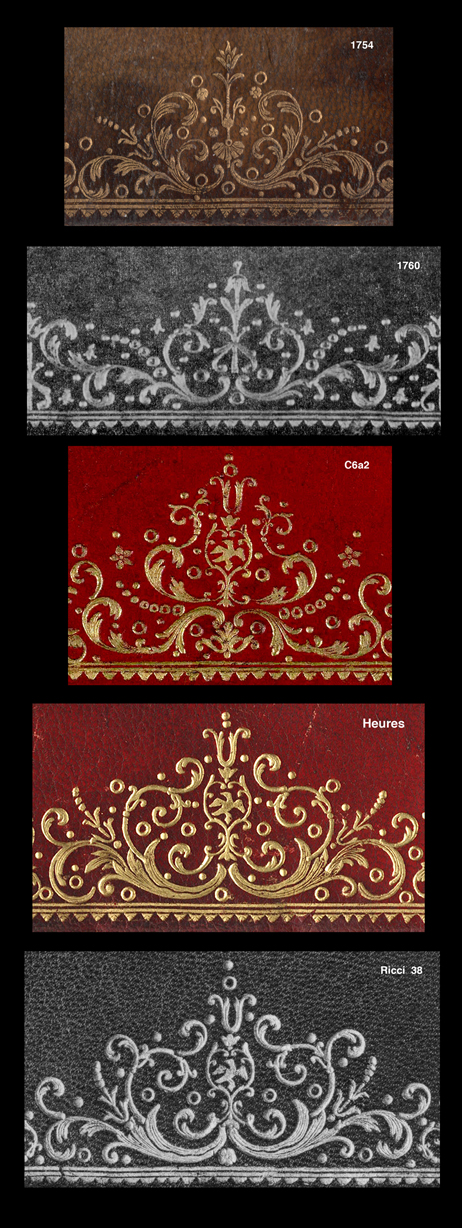
| In Comparative Diagram 2, I show a selection of bindings that have been decorated with the dj-r-1 roulette. We might guess that all the early examples of dentelle bindings by Derome are decorated with this roulette. Notice that the so called bird tool, shows up after 1760.and perhaps the dj-r-1 roulette broke sometime around 1765. I show the change in roulettes in the next diagram, you will also notice that there is a change to a thicker pair of fronds (Barber's FR 69 pair) dj-47a and 47b. (see this for references) With the change of fronds we also see 4 rings that span the middle of the decoration. These continue into the drawer-handle period, note that Davis546 and the Pompadour RES FOL-Z ADLER-33 bindings have the same crowning imprint.This is Barber's FL 91 Tulip head with three petals, referenced to W.Cat.204 a 1768 DORAT and might signal the end of the 4 ring period. On the next page we are going to look at more interesting comparisons that result from a study in the changes in these mid dentelle arrangements. |

| After assembling Comparative Diagram 2, I thought it might be instructive to assemble a greater selection of these Derome mid dentelle examples, here however the outer roulette is different, perhaps due to dj-r-1 breaking. These examples may or may not be in a chronological order however we can see that there was at some point a change to a drawer-handle roulette, we need another diagram to compare them for size. Barber has listed a number in his ROLL 6 diagram. |
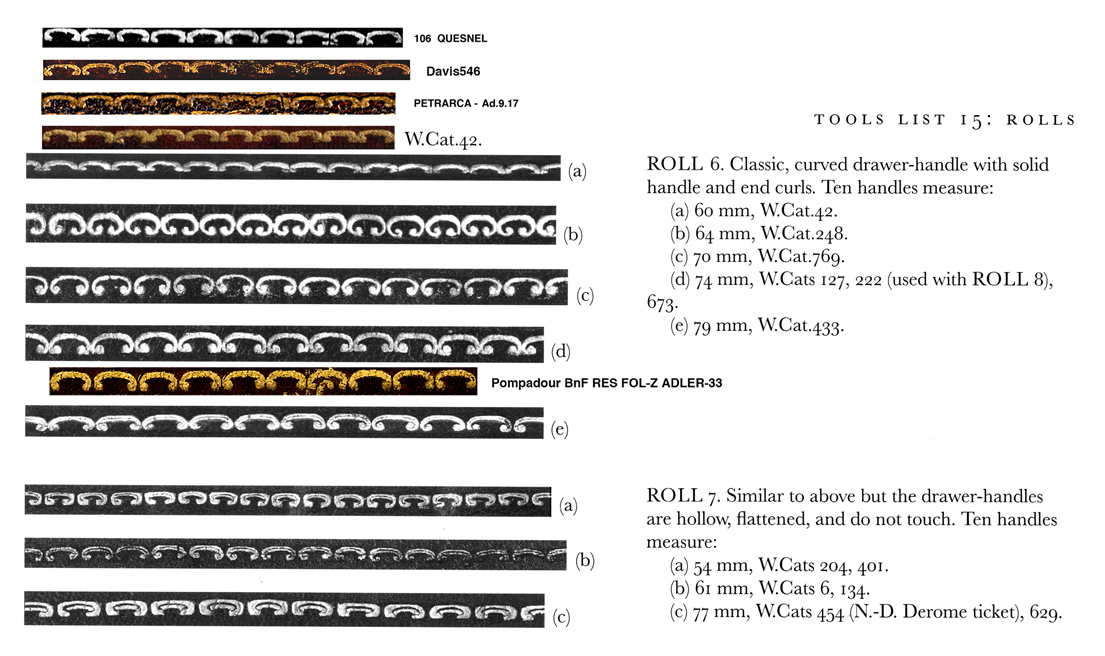
|
In Comparative Diagram 4 we see that there is one ROLL 6 example that is a close match (a) although it looks flattened compared to the Derome examples, the closest possible match is the Petrarca and that binding is full of questions with a spine decorated with Dubuisson tools (see this). Comparing roulettes could be a lifetimes work, however Barber doesn't make it any shorter, his diagrams for ROLL 6 and 7 show you examples in various lengths and sizes yet he has measured them all in a 10 handle size, and shows examples in anything but 10? I suppose he is showing them at their full length, however he gives no length information either, so we are left a bit in the dark. After hours of trying to discover the length of these drawer-handle roulettes, I have found that it is very difficult to do without high resolution scans, unless you get lucky and discover some obvious flaw or eccentricity that repeats itself. Unfortunately I have to tell you that Barber has mistakenly put example (e) in the ROLL 6 category when on closer examination it should be in the ROLL 7 group with hollow centers. |

| In Comparative Diagram 5, I have found, (finally) what I think is an actual example of this roulette that Barber chose for his type model (a). It measures 9.05 or 9.06 cm in length, the black spot is dirt or some sort of damage that effects only this single example of this roulette. This example was extracted from Barber's color reproduction of W.Cat.42 and the quality of it is not anything like a heliogravure, thus we see what looks like hash marks running across the handles, in reality these do not exist. What we are really interested in however, is the length of this roulette. As I mentioned before a roulette is a sort of DNA that defines a particular binding, it has a very specific design and exact length, when you know what that length is, you can compare it with any other similar example, if there is the slightest difference in size then you know the two items are not the same. |
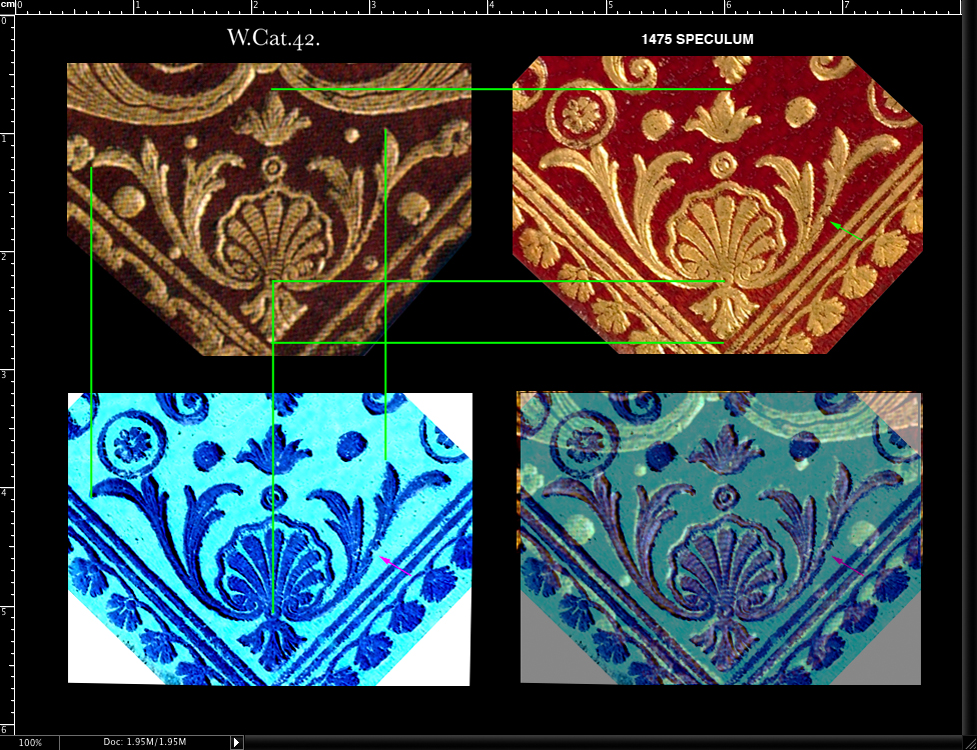
| It may happen that you want to know the exact size of the binding that you are working with, but are stuck with a low res modern reproduction with only approximate size information. For this comparative investigation of roulettes we need accurate measurements, and here is a way to do it. You find in your catalogue an imprint specimen that you know is 100 percent accurate, and you place it on a diagram with an imprint of the same type extracted from the binding that you are testing, if it is obviously not the same size then you resize it incrementally until you get it to match your accurate specimen. This can be tested with a transparent overlay, the differences, if any, become more apparent when you have reversed the color of the overlay. Measuring things with lines is another way of doing this, however both samples need to have exactly the same orientation, this sounds simple however when you attempt the overlay you will discover just how difficult it is to find an identical orientation. When you have changed the size of your test imprint, usually after a number of tests, you can find the exact size within 1 or 2 percent. If the average roulette is around 10 cm in length this means you will have, after resizing your binding to its correct size, a possible difference in the length of your roulette of about 1 to 2 mm. This then is the limit of your error, if the tested roulette is then more than a few millimetres different (say 5) you know something is not copacetic. |

| In Comparative Diagram 7, we want to find out if this drawer-handle roulette is the same as Barber's ROLL 6 model (a), Here is a conundrum, this roulette measured 9.58 cm in length i.e. 5 millimetres longer than model (a) and yet 10 handles still gave a length of 60 mm. |
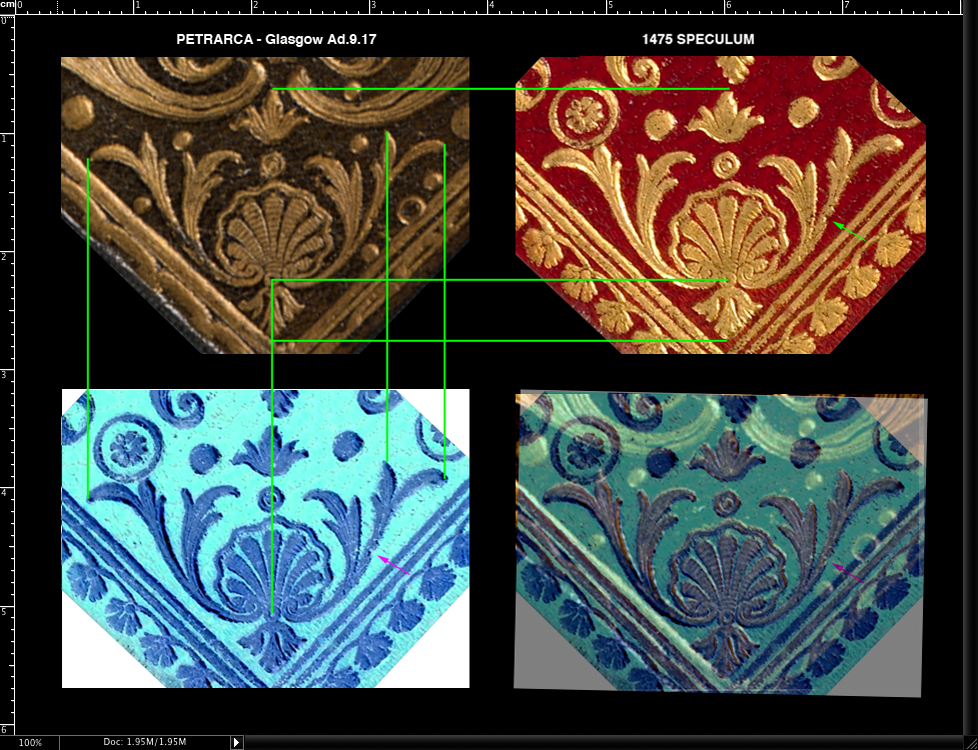
| After getting a drawer-handle length that seemed questionable, I made the same scale test with the Petrarca reproduction from the University of Glasgow Library. That reproduction proved to be accurate, so I am forced to suspect that this roulette is not the same one that was used on W.Cat.42. Still it is a tough call, because the 10 handle size of 60mm is the same. The Petrarca roulette appears to be more irregular and thinner, however only a quality reproduction of W.Cat.42 would answer these questions. |
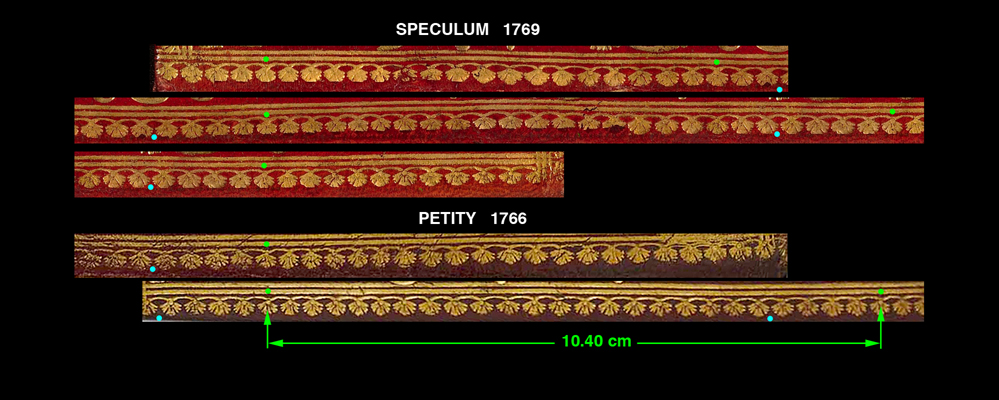
| In Comparative Diagram 9, we see a very common Derome roulette that Barber never managed to find? or catalogue. We can call it a tassel roulette, which seems easier to remember. This roulette appears late in the 60's and perhaps early 70's. A quick search appears to show that Jubert did not use this roulette? This I need to check further however it would be a great help if it turns out that for some reason his decorations are devoid of tassel roulettes. |
|
click here to return to the HOME page. click here to see the INDEX of the 2017 pages. see below links to previous work |
| Even experts are sometimes wrong, before you spend thousands on a book, please do your own research! Just because I say a certain binding can be attributed to le Maitre isn't any kind of guarantee, don't take my word for it, go a step further and get your own proof. In these pages I have provided you with a way of doing just that. |
| Virtual Bookings, created by L. A. Miller | return to the Home page of VIRTUAL BOOKBINDINGS |